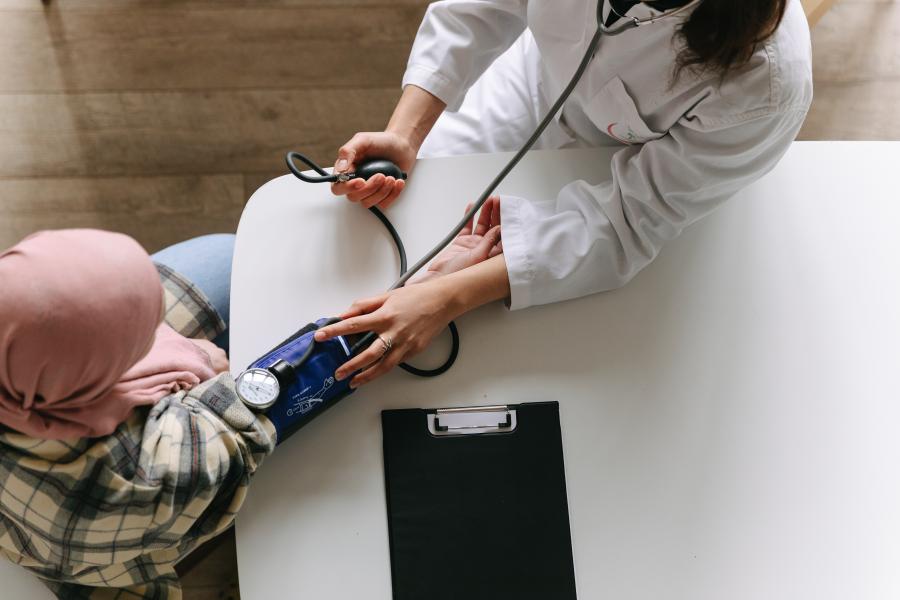Lowering Blood Pressure - What the Research Says
High blood pressure is a common health issue that people around the world experience. In fact, one out of every three adults in Bridgeport has high blood pressure. (1) High blood pressure (also called hypertension) puts more strain on blood vessels and makes it so the heart has to work harder to pump blood. Overtime, high blood pressure can lead to heart problems such as heart attacks or strokes. Scientists and doctors have worked hard to understand the causes of high blood pressure and what can help to lower it. Today we’ll look at a paper that reviews all of this scientific research to help us identify what people can do to lower their blood pressure. (2)
Some Quick Science Terms to Know
The paper reviewed a lot of different scientific studies. However, there are two important types of studies that are reviewed. They are:
- Randomized Control Trials: These are scientific studies designed for testing different treatments. In a randomized control trial (RCT for short) one group of people gets a treatment for a medical condition while another group does not. The researchers then compare the two groups to see if the people who got the treatment actually recovered more than the people who didn’t. This is important because it can show us whether the treatment actually works. If the people who got the treatment aren’t more well off than the people who didn’t, then this tells us that the treatment doesn’t work.
- Meta-Analyses: A meta-analysis is a study where the researchers combine all the findings from previous studies on a topic to get the big picture. This involves taking statistics from each of the previous studies and using them to compute one big statistic. For example, say we want to know how much potassium you need to reduce blood pressure. A meta-analysis would combine all the studies looking at how potassium intake affects blood pressure. This would give us a better idea of how much potassium you need than any of the previous studies by themselves.
Those are the main types of studies that today’s paper reviews to get their recommendations for reducing blood pressure. Now that you’re familiar with the studies that scientists use to find treatments for high blood pressure, we can get on to those treatments.
Ways to Lower Your Blood Pressure
Eat less sodium in your diet
Sodium is salt. Some examples of foods that have a lot of sodium are pizza, bacon, hotdogs, and ramen noodles. Having high levels of sodium in your diet can raise your blood pressure. Likewise, reducing the amount of sodium in your diet has been shown to lower blood pressure. Several randomized control trials (RCTs) took people with average blood pressure and gave them new diets with different levels of sodium. Changing the subjects’ diets to have more sodium makes their blood pressure rise. Changing subjects’ diets to have less sodium makes their blood pressure drop even when they did not have high blood pressure to begin with.
Eat more potassium in your diet
Potassium is a mineral that is important for healthy body functioning. Potassium is naturally found in foods like bananas, spinach, sweet potatoes, and yams. Potassium lowers blood pressure. Dozens of studies in a meta-analysis found that potassium has the opposite effect as sodium when it comes to blood pressure. Consuming more potassium in your diet lowers your blood pressure.
Eat Healthier. Consider the DASH diet
Eating healthier in general has been shown in several RCTs to lower blood pressure. Eating more fruits, vegetables, beans, nuts, and whole grains, while also eating less red meat, less sugar, and less fat reduces blood pressure. Doctors and scientists have also collaborated to create the DASH diet to lower blood pressure. DASH stands for Dietary Approaches to Stop Hypertension. To learn more about DASH, click on this link: DASH diet: Healthy eating to lower your blood pressure - Mayo Clinic.
Get more physical activity, even if it’s just a little
Being more physically active has been shown to lower blood pressure in dozens of studies. It is recommended that people get 150 minutes a week of moderate physical activity and 75 minutes a week of intense physical activity. This means about 30 minutes of physical activity a day – 20 minutes for light exercise and 10 minutes for more intense exercise. For example, if you go for a 20-minute walk and then do 10 minutes of squats or jumping-jacks every day, you should be alright. However, research shows that even just doing the 20-minute walk can help reduce your blood pressure. Sometimes I will walk up and down the stairs in my house when I can’t get on a walk outside or hit the gym.
Drink less alcohol less often
Consuming large amounts of alcohol has been shown to raise blood pressure in people all around the world. Several RCTs found that drinking less can lower your blood pressure. People who were in programs to lower the amount of alcohol they consumed each day consistently had lower blood pressure than people who drank more alcohol.
All of these are steps you can take to lower your blood pressure that are backed by science. A lot of these steps have to do with what you eat. If you follow guidance from your doctor or from the DASH diet for eating healthy, this could help your body tremendously. Of course, some people also take medication to lower their blood pressure, which can be life-saving. Make sure to check with your doctor about your blood pressure. Keeping your blood pressure in a health range will help you live longer.
Sources
- Health Improvement Alliance (2022). 2022 Community Health Needs Assessment – Greater Bridgeport. Health Improvement Alliance.
- Mills, K. T., Stefanescu, A., & He, J. (2020). The global epidemiology of hypertension. Nature Reviews Nephrology, 16(4), 223-237.

